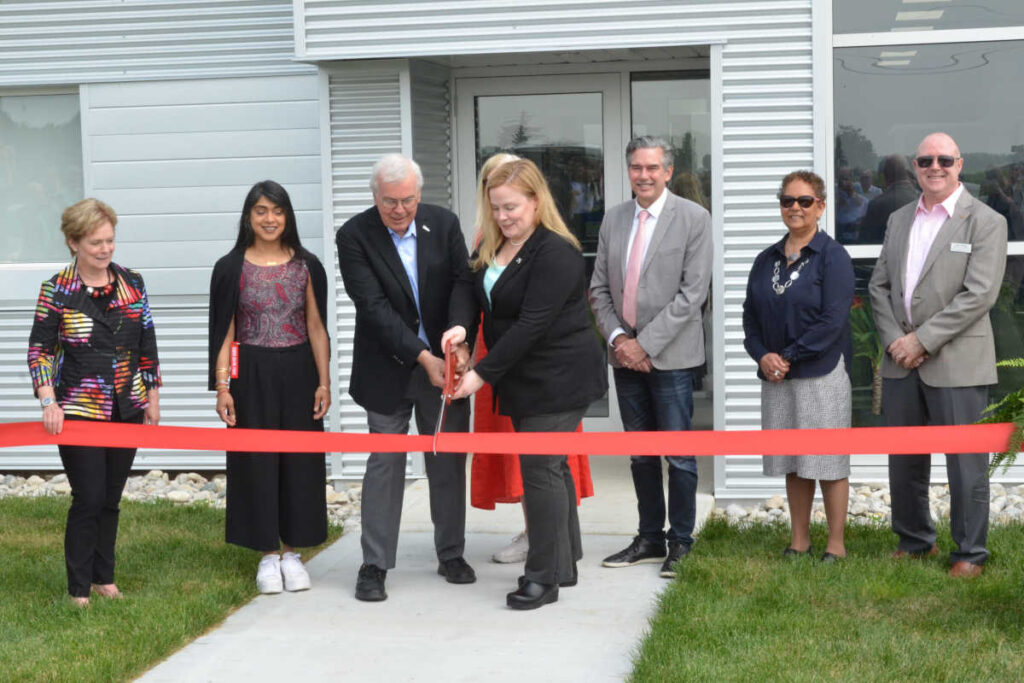
News
Training
Sustainable aviation at the Waterloo Wellington Flight Centre
July 2, 2024 By Phil Lightstone
 Celebrating the opening a 3,300-square-foot building housing a range of capabilities aimed at the future of commercial aviation strategies. (Photos: Phil Lightstone)
Celebrating the opening a 3,300-square-foot building housing a range of capabilities aimed at the future of commercial aviation strategies. (Photos: Phil Lightstone) June 21, 2024, saw the auspicious ribbon cutting and opening of the Waterloo Wellington Flight Centre’s (WWFC) new Aviation SIM Centre and Innovation Hub. The aviation industry is in the process of moving closer to a Net Carbon Zero for emissions over the next decade. That path requires substantial research and development efforts from government, academia and industry. WWFC, in conjunction with the University of Waterloo (UofW), Waterloo Institute for Sustainable Aeronautics (WISA), Federal Economic Development Agency of Southern Ontario (FedDev), Transport Canada, Pipistrel, all three levels of government and others, are leading the way in Canada to deliver an aviation training environment which achieves these goals.
With an operating budget of $11 million, the consortium is investing into Canada’s sustainable aviation and flight training environments. In 2023, WWFC graduated 375 licensed pilots, with 102 employees, 32 aircraft, 35,031 flight hours and 4,638 simulator hours.

Beginning in 2022, the consortium of WWFC, UofW and WISA, have been working on a variety of projects focusing on sustainable aviation (SA). A tangible outcome of those activities is the building of WWFC’s Aviation SIM Centre and Innovation Hub (ASCIH), located at Hangar 7 at the Region of Waterloo International Airport (CYKF). The 3,300-square-foot building housing ASCIH was designed and followed environmental and sustainable best practices including: large solar panel array and battery farm to generate and store electricity; heat pump to more efficiently heat and cool both the office space and hangar; implementation of a smart building management system, utilizing Internet of Things technologies to conserve energy, while providing an environment tailored to the needs of both the flight instructors and students. Hangar 7 is connected to the electric grid to ensure that the flight needs of the two Pipistrel Velos Electro (e-aircraft) are met.
The collaboration between the UofW, WISA and WWFC leverages FedDev funding of roughly $9.2 Million which has funded the build of the ASCIH, the acquisition of two Pipistrel electric aircraft and the research and development activities. The short-term goal of the collaboration is to understand the economic viability, electrification operational requirements and aid Transport Canada in the certification of Pipistrel’s electric aircraft. At the grand opening of ASCIH, other academic projects were displayed, inclusive of a drone equipped LDAR system used to map water in areas under dense foliage.
Rounding out Hangar 7 are four state-of-the-art flight simulators comprised of A320, 737MAX and Dash 8 Q400 simulators manufactured by Flightdeck Solutions Inc of Newmarket ON. While these simulators are not full motion simulators, they accurately replicate the flight deck environment. The 4K high resolution graphics of the imagery systems deliver a near real life experience. On a personal note, while flying the 737MAX simulator and banking the aircraft into a 45 degree turn, observers in the rear of the flight deck noted the realism of the graphics and the impact to their physiology (e.g motion sickness).
Dignitaries at the event included: Tim Louis – Member of Parliament, Kitchener-Conestoga; Karen Redman – Regional Chair, Regional Municipality of Waterloo; Dr. Charmaine Dean – Vice President, Research & International (VPRI), University of Waterloo; Dr. Suzanne Kearns – Founder, Waterloo Institute for Sustainable Aeronautics; Bob Connors – General Manager, Waterloo Wellington Flight Centre; and Tony Varga – Chairman of the Board, Waterloo Wellington Flight Centre.

“We are here today because of the longstanding partnership between the University of Waterloo and Waterloo Institute for Sustainable Aeronautics known as WISA,” said Tony Varga, Chairman Waterloo Wellington Flight Centre. “With investments exceeding $1.8 million, this new facility is now home to Boeing 737, De Havilland Q-400, and Airbus A320 professional flight training devices also known as simulators. These simulators are pivotal for training future pilots and enabling them transition to industry with valuable hands on learning and experience in the future aircraft they may fly thus lessening the transition time and cost for the airlines.
“The innovation HUB also allows WISA researchers to conduct advanced studies to help the airline industry transition into the future,” continued Varga. “This new facility is about much more than just pilot training. It is also an example of environmental stewardship utilizing state of the art air exchange heat pumps supplemented by solar energy generation and off-grid battery storage capability. This facility also houses two fully electric Pipistrel aircraft that will be used both for research and for initial pilot training as the infrastructure is built out further to support this. We deeply appreciate the support of Transport Canada in working closely with WWFC to get these aircraft flying.”
The new building was built in 14 to 15 months, which with Pandemic induced supply chain issues, is a testament to the construction team’s capabilities.
The current collaboration between the three organizations is just the beginning of an ongoing relationship which will see academic research projects becoming commercialized, beginning with the utilization of electric aircraft and the electrification of airports, FBOs and Flight Training Units. With the ongoing issues surrounding fossil fuels like 100LL and JET-1, including environmental and supply chain challenges, electrification of the aviation industry is not a matter of IF, but rather a matter of WHEN. The academic and realtime work being done by the consortium is the beginning of a journey to see meaningful change in the aviation industry as a whole. The next disruptive event will be the revolution in battery technology, with the hope of energy mass exceeding that delivered by fossil fuels.